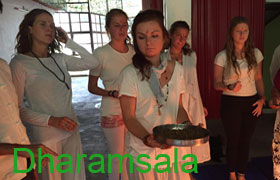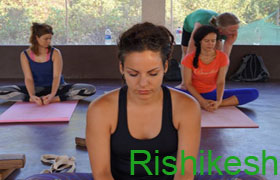Yoga Asanas for strength of the body
Asan: Through the medium of asan we can overcome the weakness of the body. It is mentioned in yoga sutra while discussing about asan – स्थिरसुखमासनम्
It means that, a posture in which we can stay happily for long time without any discomfort and without any physical effort is called asan.
Asan were taught to Godess Parvati by Lord Maheswara. According to tradition, there are 8.4 million postures of asans. Out of these there are 84 major postures which are taught in today’s society. If we practice asan, we tend to become independent of duality. Asan Prakaran describes in detail all about asans. Our yoga teacher training programs in Dharmasala provide a chance to the trainees to learn all these eighty four asans.
4 Prevention of respiratory problems through Pranayama
Pranayam prakaran elaborately describes about pranayama. As per our discussion we would not deal with such deep details but would definitely make a mention about its prime benefit. Pranayama is very effective in regularising the uncontrolled breath and eventually improve the life force and strengthen physical and mental ability. In this way, with the help of vahirang yoga i.e., yam, niyam, asan and pranayam we can rectify all kinds of mental physical defects and attain the eligibility to enter into antarang yoga. In general pratayahar is considered as the medium to enter into antarang yoga. In other words pratyahar bridges the gap between bahirang yoga and antarang yoga. The teacher training programs provided by us at Rishikesh are well known for pranayama technique.

5 Pratyahar
Abstinence of senses is called as pratyahar. It means to refrain all the senses from getting fascinated by the materialistic pleasures.
चरतां चक्षुरदीनां विषयेषु यथाक्रमं |
यत्प्रत्याहरणं तेषां प्रत्याहारः स उच्यते || (गोरक्षसंहिता)
Vision is the subject of eyes. Similarly, touch is the subject of skin, sound for ears, smell is to nose and taste is to tongue. Our senses getting attracted to these subjects is quite natural. But changing this behaviour is called pratyahar.
Bhagwan Shri Krishna in Bagavad geeta told Arjuna –
यदा संहरते चायं कूर्मोङ्गनीव सर्वशः |
इंद्रियानीन्द्रियार्थेभ्यास तस्य प्रज्ञा प्रतिष्ठिता ||
It means that, an individual should restrain his senses in all directions from their fascinations similar to the way, a tortoise folds itself into its shell. Only then can his mind attain stability.
One should not only restrain the senses but also should cease brooding over them. Else mind and senses get addicted to them. Bhagwan Shri Krishna also told Arjuna that –
ध्यायतो विषयान्पुंसः संगस्तेषूपजायते |
सांगत संजायते कामः कामत क्रोधोअभिजायते ||
क्रोधाद्भवति सम्मोहः सम्मोहित स्मृति विभ्रमः |
स्मृतिभ्रंशद्बुद्धिनाशो बुद्धिनाशात्प्रणश्यति ||
It means if an individual fails to control his mind along with his senses and eventually fails to devote himself to me; the mind of such person will be filled with the thoughts of materialistic pleasures. His mind gets attracted to these pleasures as it continues to brood over them. This attraction turns into addiction and causes for desires to originate. If these desires are not accomplished it results in anger. Anger gives rise to delusion. And delusion effects memory due to which the individual loses his intelligence. Once he loses his intelligence he would eventually drop from the path to salvation.
Thus controlling your senses through pratyahar is very much essential.




